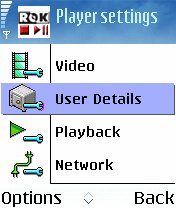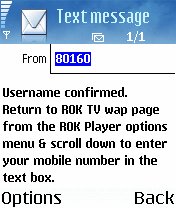Review: ROK TV
Score:
85%
Buy Link | Download / Information Link
When offered the chance to review ROK TV, the very first thing I did was make sure their PR company lent me a SIM card with plenty of credit on it - I had the feeling that a TV solution was going to hammer the GPRS network pretty hard and I didn't want to be the one paying for it. I was right.
 ROK TV is a professional streaming solution for live television that works (really) over traditional 2.5G networks. In other words, using standard GPRS data at a relatively modest 4K of data per second. At the moment, ROK TV's in its 'try me' stage, hoping for network operators to pick up on the huge potential in terms of data traffic over their network and then to license the system.
ROK TV is a professional streaming solution for live television that works (really) over traditional 2.5G networks. In other words, using standard GPRS data at a relatively modest 4K of data per second. At the moment, ROK TV's in its 'try me' stage, hoping for network operators to pick up on the huge potential in terms of data traffic over their network and then to license the system.
At the moment, the only live channels are ITN News 24, CNN, Cartoon Network, Tidy TV, SN TV and F3. Of which only the first two are genuinely and innovatively live, of course. There are a few other channels repeating the same recorded material. This may not seem a very big channel range, but it's jaw-droppingly impressive seeing live broadcast TV on your smartphone for the very first time. Part of you will scream inside 'YEESSS'. This is how live news should appear on your handset. It's a true killer app.
The problem is that your wallet will (more loudly) shout 'NOOO'. Now, please hear me, what I'm about to say is not in any way ROK TV's fault, which is why I gave it such a high score above. ROK TV itself is a really well-programming application, playing back streaming TV video with only the occasional stutter. To do what it does over GPRS is astounding. Here's a video clip of ROK TV in action, recorded on another smartphone, just to prove that it works: roktv.mov, 166K.
It's the amount of data traffic that's required for prolonged watching that's the issue here. In my tests, I watched ROK TV channels for around 40 minutes in all, over the course of an afternoon. This equated to somewhere around 8MB of GPRS data, costing well over £20 on the Orange tariff being used. Let's restate that. £20 for watching 40 minutes of TV that could be viewed (more or less, in terms of pro rate costs) for free over your terrestrial aerial or cable service. Yes, it's more convenient to watch TV on your phone, wherever you are, but at 250K per minute it's going to really kill your mobile bill if you make any serious use of ROK TV. At the moment.
You see, ROK TV is crying out for use with an unlimited (or really sizeable) GPRS data tariff. 50MB a month is the right sort of region for watching ROK TV for an average of 10 minutes a day. Vodafone are leading the pack here, with a genuinely unlimited deal for £45 a month, but that's on top of your usual tariff, making this still a very expensive luxury. What's needed is not for ROK TV (and other similar applications in the future) to reduce its bandwidth, but for the UK networks to reduce their GPRS (data) rates. Yes, they'll make less profit in the short term, but once Internet-driven mobile TV takes off, they'll make a lot more in the medium and long term. ROK's standard suggested deal is that operators sell ROK TV to customers as a £10 a month service that includes 5MB of data. Which sounds about the right level in terms of price, except that this equates to an average of only one minute per day, so low as to not really be worth bothering with.




Ignoring the bandwidth/cost issue, ROK TV is impressive. The setup process is a little involved, with some to and froing between the ROK WAP site and the application itself, and with an activation delivered by SMS. Still, 10 minutes after sitting down with ROK TV, I was starting to watch content. The video stream only plays back at around 10 frames per second, but for a picture size of 208 pixels in width (by, typically, about 150 pixels in height), it's actually good enough. There's an annoying (but necessary) 30 second wait after selecting one of the eight 'standard' channels, with this buffer being needed to build up a sequence of frames which will then flow smoothly. The frame rate drops occasionally for fast moving pictures (e.g. pans across a scene) and also for GPRS connection bottlenecks at certain times of day, but on the whole the illusion of picking up TV on your phone is complete. It's pretty addictive, too, with a real novelty value, and you won't be able to resist showing it off to your friends and colleagues.







The other way in which this implementation of ROK TV is slightly ahead of its time is that it's currently only compatible with modern Series 60 smartphones, so UIQ and Series 80 units are not supported, let alone Windows Mobile smartphones. And it's also 'currently not available on 3, Virgin, and O2 pay as you go'. And it's only available in the UK.
But this is all for the current, DIY installation, so consider it a technology preview. By this time next year, I'd be very surprised if ROK TV (or similar) wasn't far more affordable and more compatible, sourced through your network provider.



In summary, a well deserved 85% for the technology and software. Now all we need is a time machine to fast forward us to Autumn 2006...
Reviewed by Steve Litchfield at
